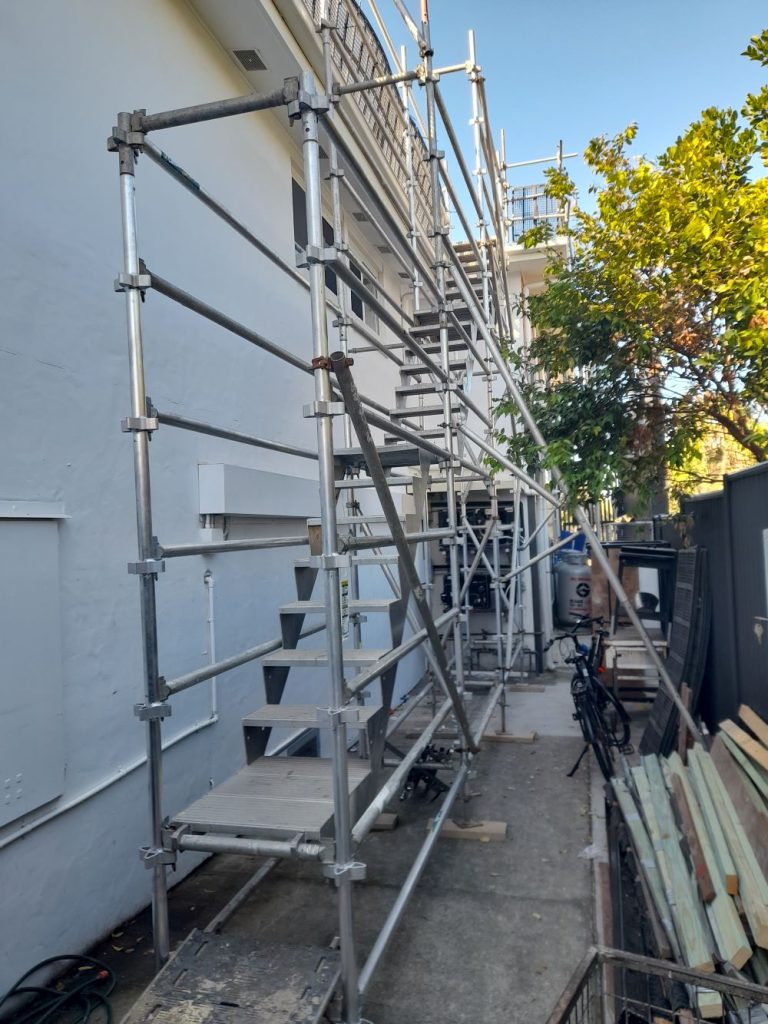If you have ever worked in proximity to scaffolding, you may have contemplated the safety and practicality of positioning a ladder on top of it to gain access to elevated areas. While this approach may appear to be a straightforward and convenient solution, it is imperative to consider the critical safety implications that must be assessed before proceeding. A comprehensive understanding of the risks and regulations surrounding this practice is vital to ensure the safety of yourself and others within the work environment.
Although it may seem uncomplicated, the act of utilising a ladder on scaffolding is EXTREMELY hazardous. The introduction of ANY additional items to a stable scaffolding structure can pose serious dangers. The risks associated with this practice are considerable and should never be underestimated or dismissed. It is essential to prioritise safety over convenience in any construction setting to avoid potential accidents and injuries.
This article will delve into the numerous reasons why placing a ladder on scaffolding is inadvisable. We will highlight the potential hazards involved and discuss safer alternatives that should be seriously considered instead.

Comprehending the Safety Hazards of Using a Ladder on Scaffolding
The unequivocal response is NO; employing a ladder on scaffolding is NOT safe.
The utilisation of a ladder on scaffolding introduces significant threats that can compromise the safety of the entire assembly. The primary purpose of scaffolding is to function as a secure and stable working platform that meets strict load-bearing standards. When a ladder or any additional equipment is positioned on this structure, it can destabilise the entire system, thereby elevating the risk of accidents, falls, and severe injuries. Thus, while it may seem like a clever shortcut to access a higher area, the potential hazards far outweigh any perceived benefits.
Also Read: What NOT to Do When Using Scaffolding for Safety
Uncovering the Specific Dangers Linked to Ladder Use on Scaffolding
Having established that using a ladder on scaffolding is unsafe, let’s take a more in-depth look at the specific dangers associated with this practice:
1. Instability of the Scaffolding Structure
Scaffolding is meticulously engineered as a secure and robust working platform; however, the introduction of a ladder can significantly disrupt this equilibrium. Ladders are specifically designed to be positioned on solid ground rather than atop another structure. When a ladder is set on scaffolding, it can destabilise the entire framework, thereby considerably increasing the risk of falls, slips, or even complete scaffold failure. This precarious situation poses a serious threat not only to the user but also to everyone in the vicinity, making it a dangerous practice.
2. Increased Fall Risk Due to Heightened Elevation
When working on scaffolding, you are already elevated above ground level. Adding a ladder can further raise this elevation, consequently amplifying the risk of falling. The precariousness of using a ladder on scaffolding creates hazardous situations, particularly if the ladder shifts, slips, or fails to maintain stability. The potential for severe injuries escalates dramatically with higher falls, rendering this practice extremely risky and inadvisable.
Also Read: Who Is Responsible for Scaffold Hire and Safety?
3. Incorrect Ladder Angle Heightens Accident Risks
Ladders are specifically designed to be utilised at particular angles to ensure safety during operation. Placing a ladder haphazardly on top of scaffolding prevents achieving the correct angle necessary for stability. An improperly positioned ladder is more susceptible to slipping or sliding, especially when placed on a surface that lacks solidity and support. Furthermore, scaffolding does not provide the same level of stability as a solid ground surface, making it challenging to secure the ladder at the appropriate angle, thus increasing the likelihood of accidents occurring.
4. Inadequate Secure Attachment Results in Significant Hazards
When utilising a ladder on scaffolding, it often results in insufficient securing of the ladder itself. Most scaffolding setups are not designed to accommodate ladders, meaning there is generally no reliable method to attach them securely. Although the ladder may initially appear stable, any movement, vibrations, or slips can quickly cause the ladder to fall or tip over, presenting a grave risk to users and those nearby.
5. Breaching OSHA Safety Regulations Leads to Serious Consequences
If you are engaged in work on a construction site, adherence to safety regulations is often mandated. The Occupational Safety and Health Administration (OSHA) enforces stringent guidelines that govern the safe use of scaffolding and ladders. Improper use of a ladder on scaffolding can lead to violations of OSHA standards (such as 1926.1053 for ladders and 1926.451 for scaffolds). Non-compliance can result in legal repercussions, fines, penalties, or even project shutdowns, making it essential to diligently follow safety guidelines.
6. Risks of Certification Nullification Due to Unsafe Practices
Every scaffolding installation undergoes rigorous certification processes to ensure that professionals have deemed it safe for use. Altering that setup by adding a ladder compromises its certification status. In the event of an incident, you may find yourself without coverage regarding work health and safety regulations. Without valid certification, you assume significant risk, which is an unacceptable gamble that could yield dire consequences.
Identifying Safer Alternatives for Accessing Elevated Areas
Having thoroughly examined the reasons against using a ladder on scaffolding, let’s explore safer alternatives for achieving desired heights without compromising safety or breaching regulations:
Leverage Built-In Scaffold Access Solutions for Enhanced Safety
Most scaffolding installations feature built-in access solutions, such as ladders or stairways. These access points are specifically designed to ensure safety while navigating up and down the scaffolding structure. If your scaffolding incorporates these built-in access options, it is crucial to fully utilise them! They are engineered to work seamlessly with the scaffolding system, significantly enhancing overall security and minimising the likelihood of accidents occurring.

Explore Work Platforms or Extensions for Safer Access to Heights
Another effective alternative is to employ a work platform or an extension. These solutions are specifically designed to provide a stable surface for working while offering safe access to higher levels. They represent a more secure option compared to attempting to balance a ladder on scaffolding. Work platforms are robust and certified for use with scaffolding, ensuring your safety while enabling the efficient and effective completion of tasks at elevated heights.
Final Reflections on the Use of Ladders with Scaffolding
So, can you safely place a ladder on scaffolding?
The definitive answer is no! Employing a ladder on scaffolding can lead to structural instability, increased fall risk, and violations of essential safety regulations. The potential consequences simply do not justify the associated dangers. Instead, take advantage of built-in scaffold access methods or opt for safer alternatives like work platforms. Always prioritise safety; the last thing you want is to jeopardise your well-being or that of others for the sake of convenience. By adhering to proper guidelines, you will ensure that you remain safe and compliant while on the job.
The Article: Ladder Safety on Scaffolding: What You Need to Know first appeared on https://writebuff.com
The Article Ladder Safety Tips for Scaffolding You Must Know Was Found On https://limitsofstrategy.com


You raise such an important point about safety on construction sites. It reminds me of a time when I was helping out on a project where someone thought it would be a quick fix to balance a ladder on scaffolding to reach a hard-to-get spot. We ended up having a tense moment when the entire structure wobbled—it definitely wasn’t worth the risk for a couple of extra feet.